Numerical Simulation of Slope Excavation and Stability Under Earthquakes in Cataclastic Loose Rock Mass of Hydropower Station on Lancang River
Abstract
1. Introduction
2. General Situation
3. Discrete Element Numerical Simulation
3.1. Interpretation of Dominant Structural Plane
3.2. DFN Discrete Fracture Network (DFN)
3.2.1. Division of Discrete Fractures
3.2.2. Discrete Fracture Assignment
3.3. Excavation Line Layout and Model Establishment
3.4. Boundary Conditions and Calculation Parameters
3.5. Selection of Seismic Wave
4. Analysis of Numerical Calculation Results of 3D Model for Excavation Response of Cataclastic Loose Rock Slope
4.1. Analysis of Slope Displacement Field
4.2. Displacement Field Analysis of Typical Section
4.2.1. Horizontal Displacement Characteristics
4.2.2. Vertical Displacement Characteristics
4.2.3. Total Displacement Characteristics
4.3. Characteristic Analysis of the Monitoring Points
4.3.1. Displacement Monitoring Curve in Y Direction
4.3.2. Displacement Monitoring Curve in Z Direction
4.3.3. Deformation Rate Monitoring Curve
5. Analysis of Numerical Calculation Results on Support Effect for Fractured Loose Rock Slopes
5.1. Design of Support Scheme for Excavation Slope
5.2. Displacement Field Analysis After Slope Support
5.3. Typical Section Displacement Field Analysis After Slope Support
5.4. Characteristic Analysis of Monitoring Points After Implementation of Support Measures
5.4.1. Displacement Monitoring Curve in Y Direction
5.4.2. Displacement Monitoring Curve in Z Direction
5.4.3. Deformation Rate Monitoring Curve
6. Stability Analysis of Cataclastic Loose Rock Slope After Support Under Seismic Conditions
6.1. Analysis of Overall Stability of Slope
6.2. Displacement Field Analysis of Typical Section
6.3. Deformation Rate Analysis of Typical Section
7. Conclusions
- (1)
- The cataclastic loose rock mass and Qedl sediment on the shallow surface of the excavation face exhibit the main deformation and failure areas after excavation. Moreover, unloading rebound occurs on the excavation slope and steps to varying degrees. The rock mass is likely to slide and deform to the free face along the interface between the cataclastic loose rock mass and the toppling-deformed rock mass at the lower part of the excavation face, greatly affecting the slope stability.
- (2)
- Adopting the method combining preliminary shaft micropiles and Macintosh reinforced pads is feasible and effective. Following the implementation of support measures, the maximum displacement value of the entire slope in the Y and Z directions near the excavation face is considerably reduced, along with the extent of its influence. Moreover, the peak rate of each monitoring point decreases remarkably, but the deformation and displacement at the intersection of the cataclastic loose rock mass and Qedl sediment must be monitored in the actual project.
- (3)
- Under a seismic load, the fractured loose rock slope of the mixing plant after support illustrates large displacement on the shallow surface of the excavation slope, and the collapse deformation is predominantly shear failure. The damage is concentrated near the Qedl sediment and cataclastic loose rock mass, and the supporting measures at these two places must be strengthened.
Author Contributions
Funding
Institutional Review Board Statement
Informed Consent Statement
Data Availability Statement
Conflicts of Interest
References
- Hopkins, D.L. The implications of joint deformation in analyzing the properties and behavior of fractured rock masses, underground excavations, and faults. Int. J. Rock. Mech. Min. 2000, 37, 175–202. [Google Scholar] [CrossRef]
- Hatzor, Y.H.; Arzi, A.A.; Zaslavvsky, Y. Dynamic stability analysis of jointed rock slopes using the DDA method: King Herod’s Palace, Masada, Israel. Int. J. Rock. Mech. Min. 2004, 41, 813–832. [Google Scholar] [CrossRef]
- Wang, C.; Tanant, D.D.; Lilly, P.A. Numerical analysis of the stability of heavily jointed rock slopes using PFC2D. Int. J. Rock. Mech. Min. 2003, 40, 415–424. [Google Scholar] [CrossRef]
- Meng, Q.M. Analysis of xibang loose rock mass and slope stability in Xiaolongtan coal mine. J. Geol. Hazards Environ. Preserv. 1996, 37–43. [Google Scholar]
- Zheng, D.; Wang, Y.; Yao, Q.; Li, W.L. Cataclastic Loose Rock Mass on the Abutment Slope of a HydropowerStation: Development Characteristics and Excavation Deformation Response. J. Chang. River Sci. Res. Inst. 2019, 36, 50–56. [Google Scholar] [CrossRef]
- Wang, M.; Jiang, T.T. Study on Seepage and Stability Characteristics of Cataclastic and Relaxed Rock Mass Slope under the Snow Melting Condition. Pearl River 2019, 40, 56–61+88. [Google Scholar] [CrossRef]
- Liu, W.G. Analyzing Development Characteristicscauses to 1# Ripping Loose Rock Mass of Yagen Hydropower Station; Chengdu University of Technology: Chengdu, China, 2009. [Google Scholar]
- Jia, L.J. Stability Study to 2# Ripping Loose rock Massslope of Yagen Hydropower Station; Chengdu University of Technology: Chengdu, China, 2009. [Google Scholar]
- Xie, Y. Equivalent Research on Engineering Characteristics of Cataclastic Rockmass and its Engineering Application; Chengdu University of Technology: Chengdu, China, 2010. [Google Scholar]
- Hu, Y.F.; Shen, J.H.; Nie, D.X. Engineering Suitability Research on the Tension-slackened Rock Mass in Yagen Hydropower Station. J. Hydroelectr. Eng. 2011, 34, 28–30. [Google Scholar] [CrossRef]
- Han, W.F.; Chen, W.W. Study on Engineering Characteristics of the Dynamo-Relaxed Rockmass. Chin. J. Rock Mech. Eng. 2000, 26, 751–755. [Google Scholar]
- Wang, Z.Y.; Qi, W.; Men, Y.M.; Peng, J.B. Tectonic control on water hazards of coal mine in Henan Province. Coal Geol. Explor. 2004, 32, 48–53. [Google Scholar] [CrossRef]
- Yuan, Y. The Analysis of Genetic Mechanisms of Broken Loose Rock Mass and Stability on the left bank of the Middle Dam Area of a Hydroelectric Power Station in Lancang River; Chengdu University of Technology: Chengdu, China, 2016. [Google Scholar]
- Jiang, S.N. Research on Physical and Mechanical Properties and Damage Characteristics of Freeze-Thaw Rock in Alpine Mountain Regions—Taking the Dacite of a Proposed Hydropower Station Dam Area as an Example; Chengdu University of Technology: Chengdu, China, 2016. [Google Scholar]
- Singh, M.; Rao, K.S. Empirical methods to estimate the strength of jointed rock masses. Eng. Geol. 2005, 77, 127–137. [Google Scholar] [CrossRef]
- Zou, J. Development Characteristics and Stability Study on Cataclastic Loose Rock Mass in the Alpine Mountain Regions and Deep Valley; Chengdu University of Technology: Chengdu, China, 2016. [Google Scholar]
- Huang, P.; Zhang, M.; Qiao, P. Study on the Genetic Mechanism of Cataclastic Loose Rock Mass on the Lancang River Basin of the Qinghai -Tibet Plateau. Pearl Revier 2018, 39, 44–53. [Google Scholar]
- Wu, S.Y.; Li, P.F.; Chen, Z.H. Study on the Engineering Characteristics of Cataclastic Relaxed Rock Mass in High-cold Canyon. Chin. J. Undergr. Space Eng. 2018, 14, 1250–1257. [Google Scholar]
- Guo, L.N.; Cao, X.X.; Jia, H. Stability Analysis and Prevention of High Slope with Broken Loose Rock Mass. J. Water Resour. Archit. Eng. 2021, 19, 42–47+88. [Google Scholar] [CrossRef]
- Sembenelli, P. Secondary movements during excavations. In Proceedings of the 4th Congress of the International Society for Rock Mechanics, Montreux, Switzerland, 2–8 September 1979; pp. 397–400. [Google Scholar]
- Ugai, K. A method of calculation of total factor of safety of slopes by elasto-plastic FEM. Soils Found 1989, 29, 35–40. [Google Scholar] [CrossRef] [PubMed]
- Matsui, T.; San, K.C. Finite element slope stability analysis by shear strength reduction technique. Soils Found 1992, 32, 43–70. [Google Scholar] [CrossRef]
- Fang, G.; Wei, G.; Jun, T.J. Research on Deformation Stability of Soft Rock Slope under Excavation Based on FLAC3D. Appl. Mech. Mater. 2013, 275–277, 290–294. [Google Scholar] [CrossRef]
- Du, W.; Chen, X.; Cheng, L.L.; Jiang, H.; Wang, W. Parametric Analysis of Rock Mass during Excavation and Unloading of Rock Slope. J. Disaster Prev. Mitig. Eng. 2023, 43, 596–603. [Google Scholar] [CrossRef]
- Zhao, W.H.; Huang, R.Q.; Zhao, J.J. Rockfall Mechanism of Cataclastic Rock Mass and Influence of Back Wall Upon the Stability of Accumulation Under Strong Earthquake. J. Eng. Geol. 2011, 19, 205–212. [Google Scholar]
- Sitharam, T.G.; Latha, G.M. Simulation of excavations in jointed rock masses using a practical equivalent continuum approach. Int. J. Rock. Mech. Min. 2002, 39, 517–525. [Google Scholar] [CrossRef]
- Niu, Y. Study on the Method of Rapid Identification of Perilous Rock Mass by 3D Laser Scanning; Chengdu University of Technology: Chengdu, China, 2020. [Google Scholar]
- Ning, H. Recognition and Information Extraction of Rock Mass Structural Plane Based on 3D Laser Scanning; Chengdu University of Technology: Chengdu, China, 2020. [Google Scholar]
- Sha, P.; Kong, D.H.; Wang, S.L. Identification of Rockmass Discontinuities and 3D Discrete Element Modeling of High Slope Based on Unmanned Aerial Vehicle Photogrammetry. J. Eng. Geol. 2022, 30, 1658–1668. [Google Scholar] [CrossRef]
- Du, P.; Xu, Y.; Guo, Y. Assessing loess landslide volume using high-precision UAV-derived DEM: A case study of the 15 March 2019 landslide in Zaoling Township, Xiangning County in North China. Nat. Hazards Res. 2023, 3, 640–645. [Google Scholar] [CrossRef]
- Li, L.Q.; Ju, N.P.; Zhang, S. Seismic wave propagation characteristic and its effects on the failure of steep jointed anti-dip rock slope. Landslides 2019, 16, 105–123. [Google Scholar] [CrossRef]
- Zheng, Y.; Wang, R.Q.; Chen, C.X. Dynamic analysis of anti-dip bedding rock slopes reinforced by prestressed cables using discrete element method. Eng. Anal. Bound. Elem. 2021, 130, 79–93. [Google Scholar] [CrossRef]
- Sheng, J.; Li, X.D. Determination of mechanical parameters of rock mass based on Hoek Brown strength criterion. Min. Technol. 2009, 9, 12–14+33. [Google Scholar] [CrossRef]
- Shi, X.; Zhao, D.J.; Song, S.Y. Face stability analysis of the circular tunnels in fractured rock masses based on the nonlinear Hoek-Brown failure criterion. Chin. J. Rock Mech. Eng. 2020, 39, 3359–3366. [Google Scholar] [CrossRef]
- Tian, M.L. HOEK-BROWN Criterion Parameter Optimization and Its Applications in Engineering; Shandong University of Science and Technology: Qingdao, China, 2018. [Google Scholar]
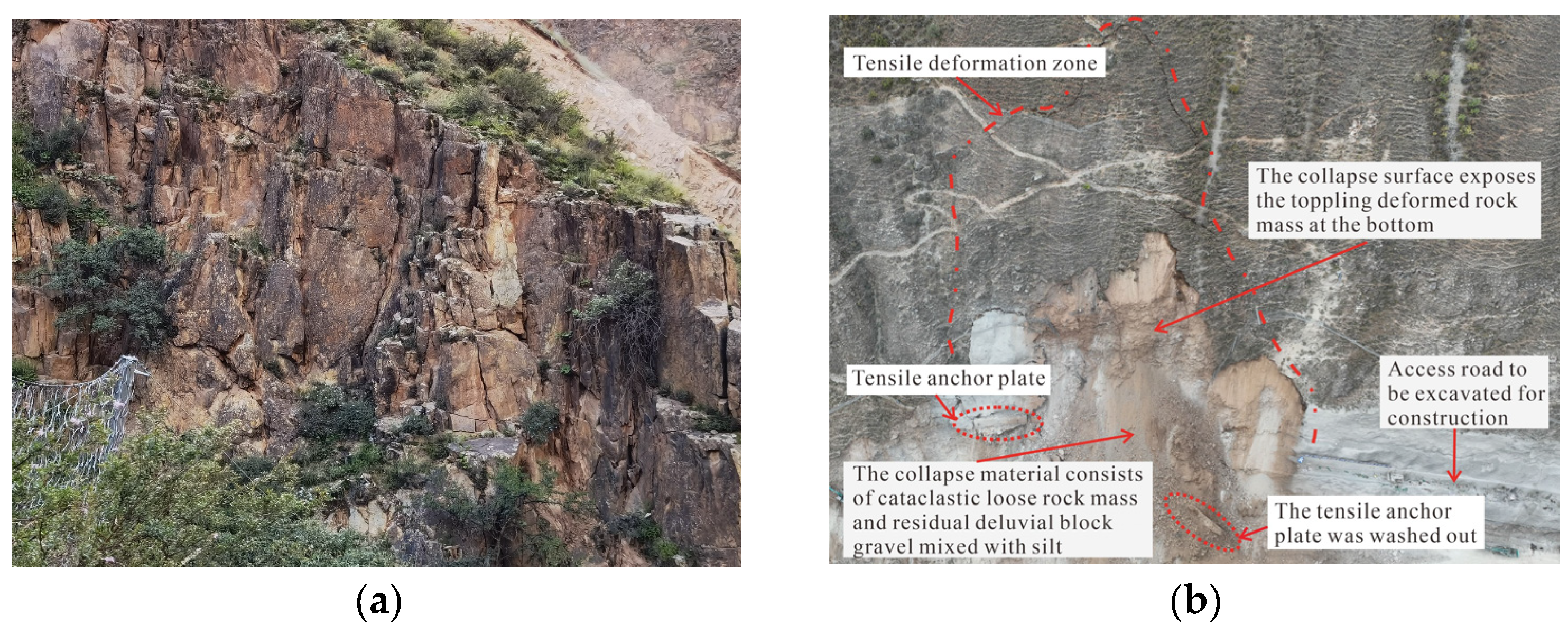
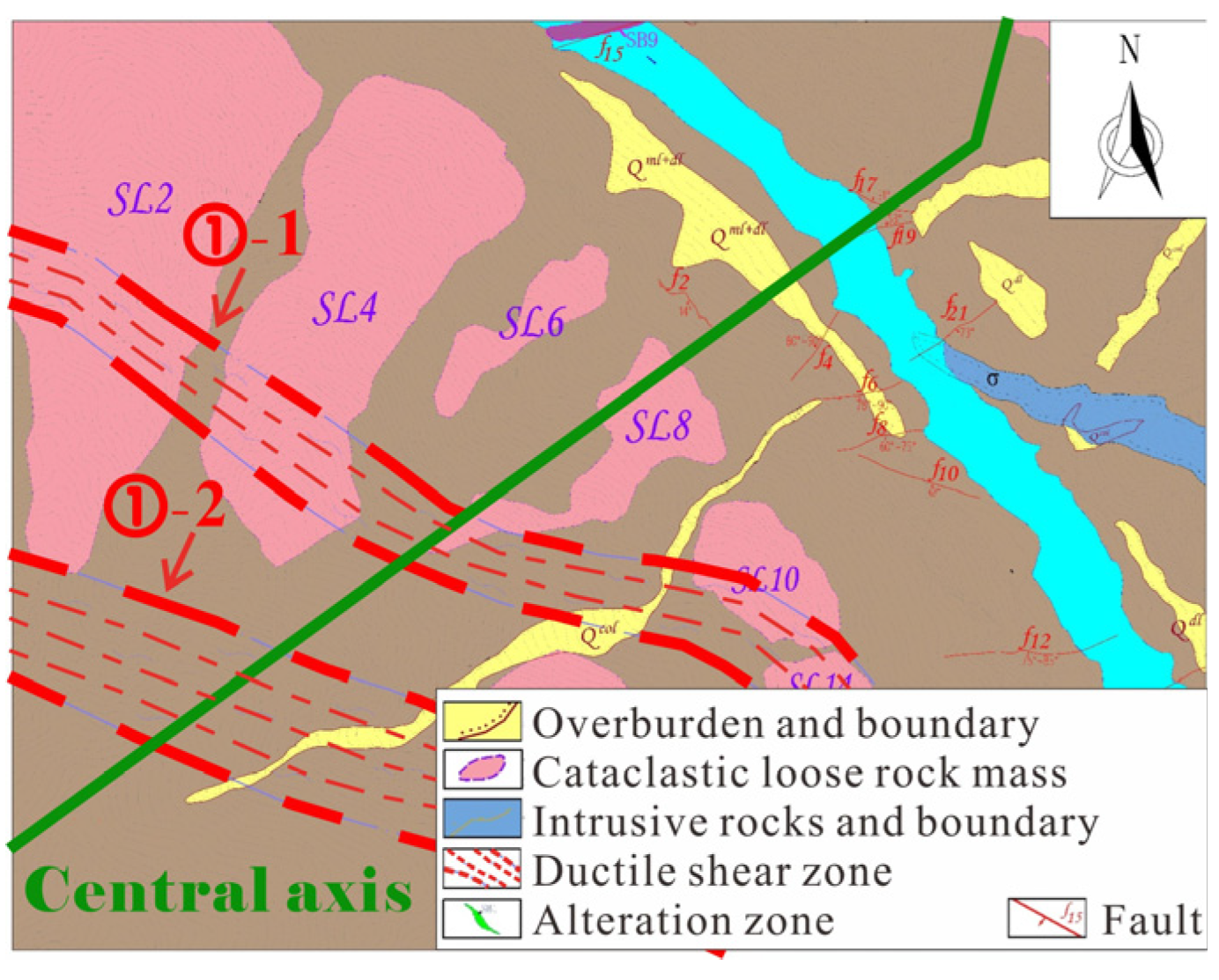
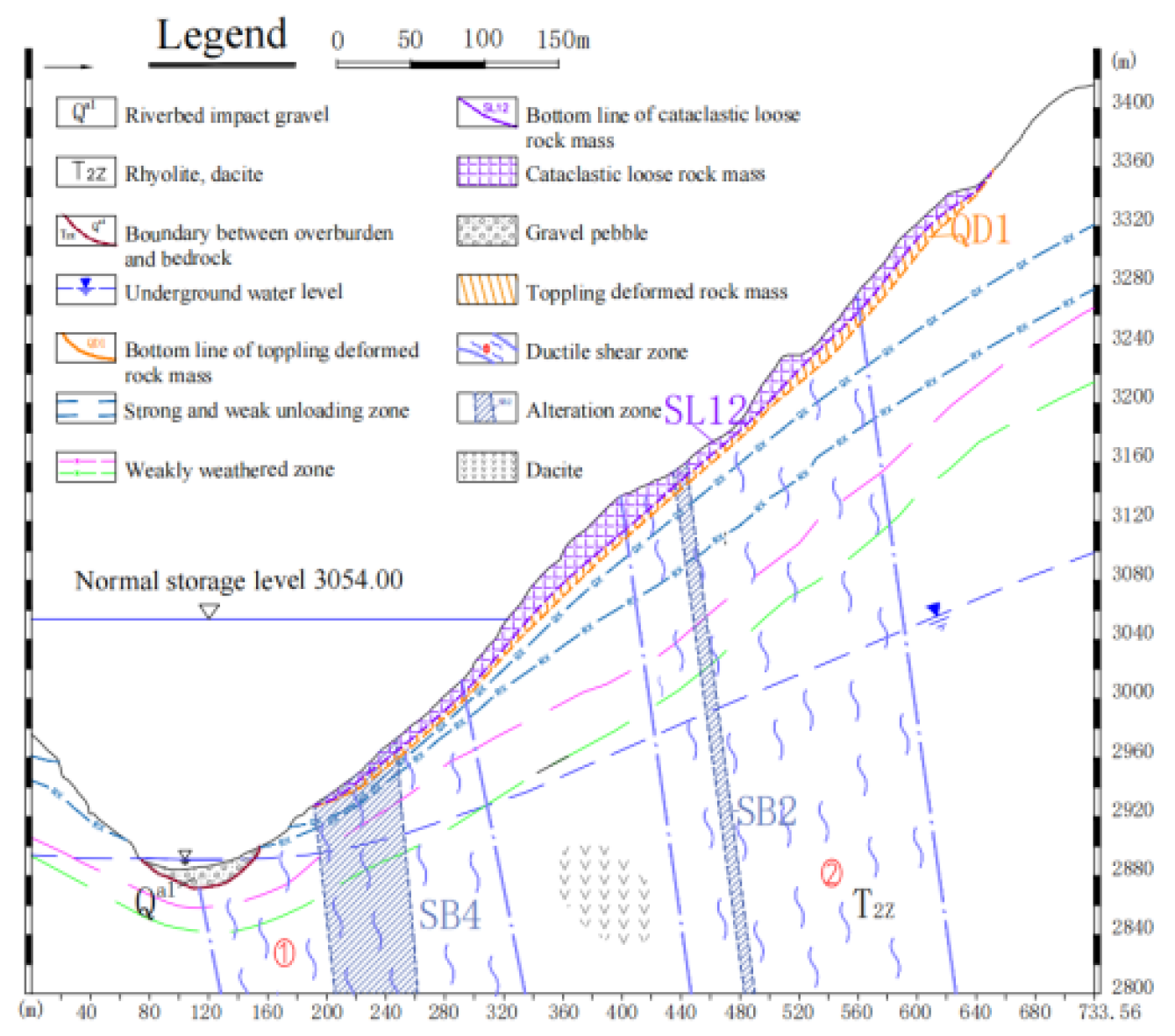




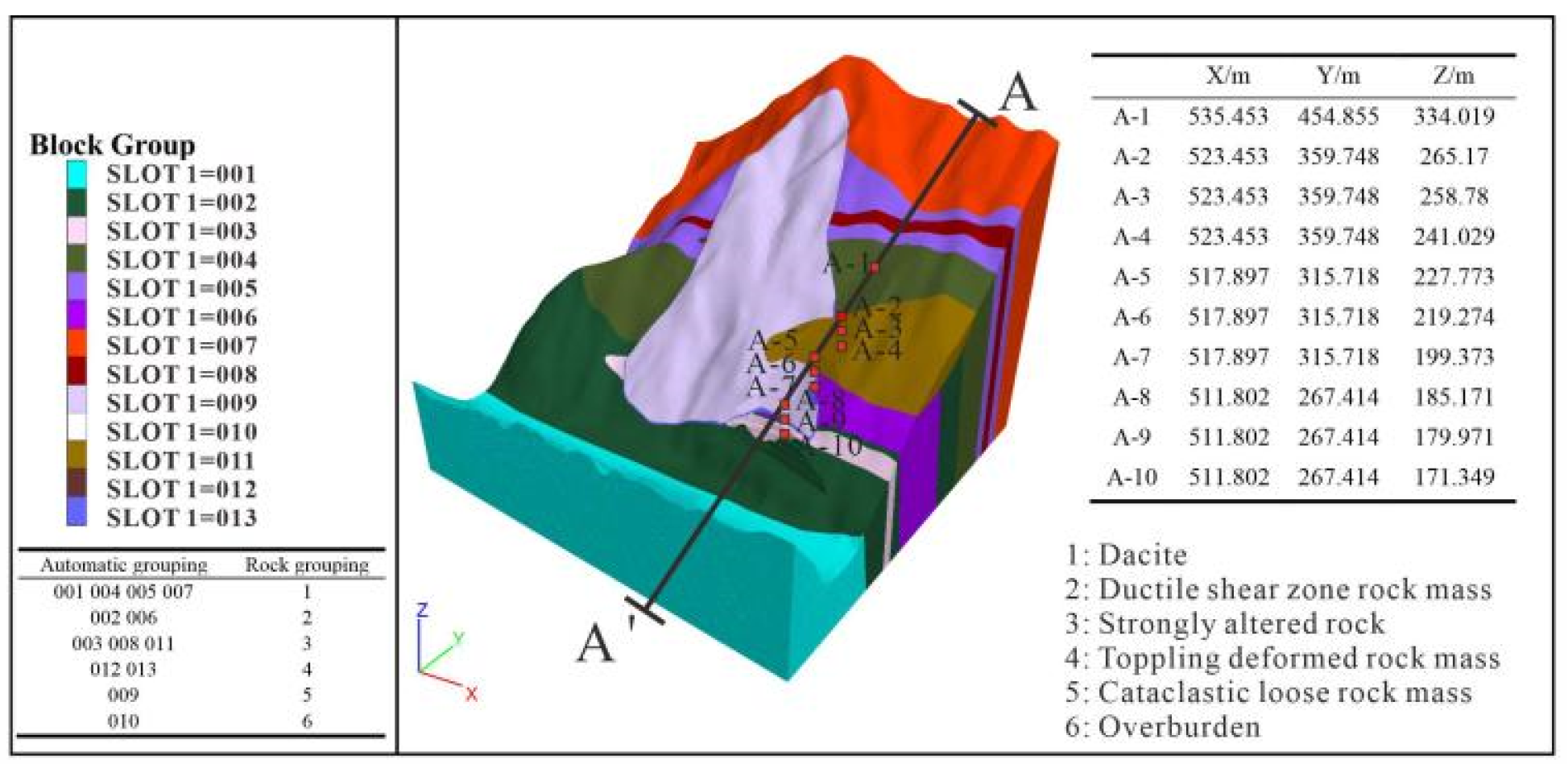
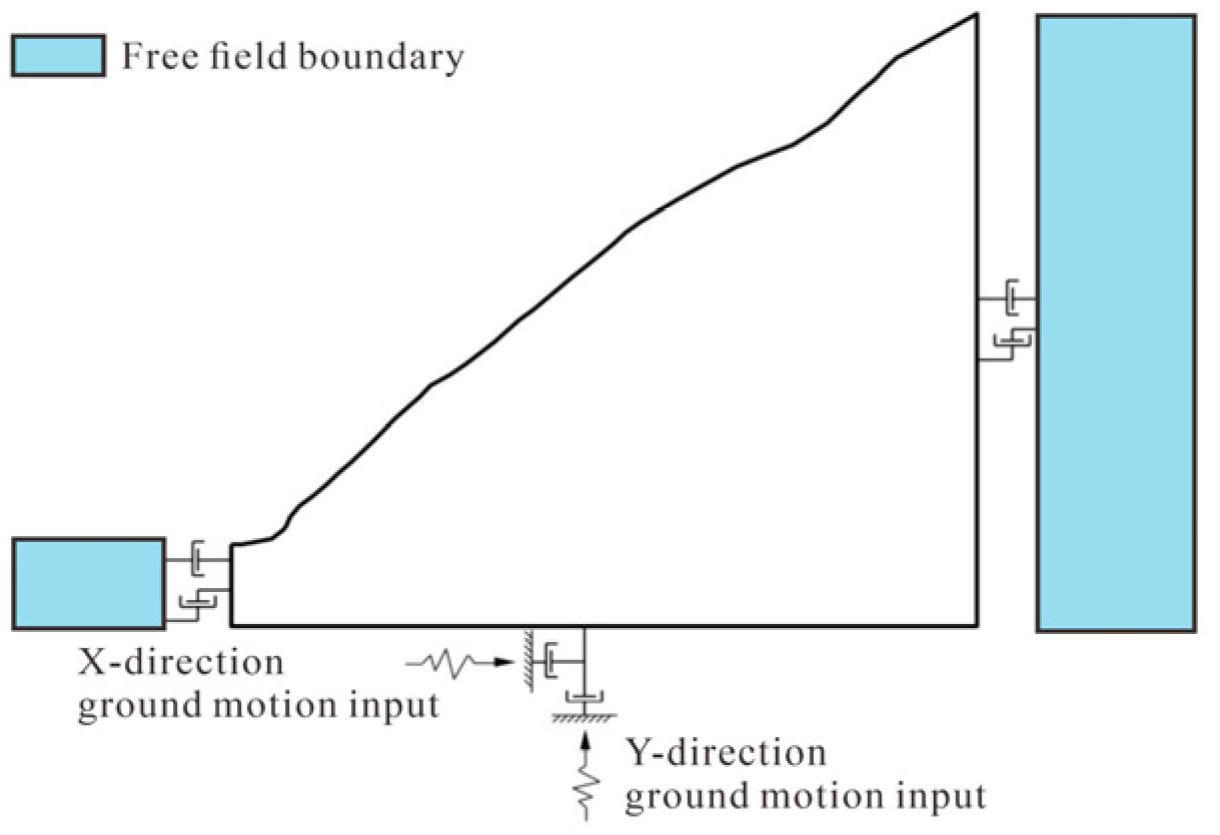









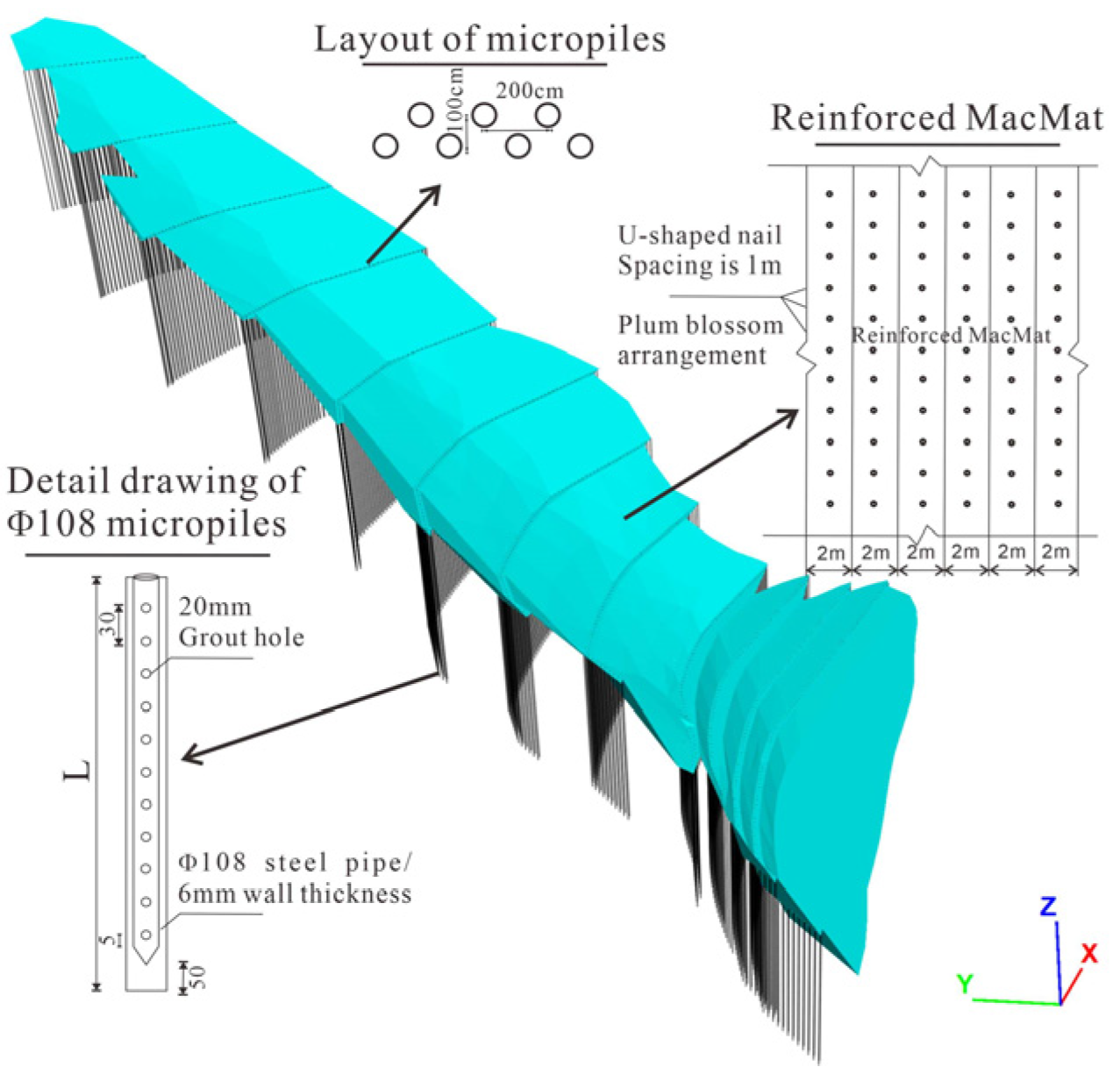





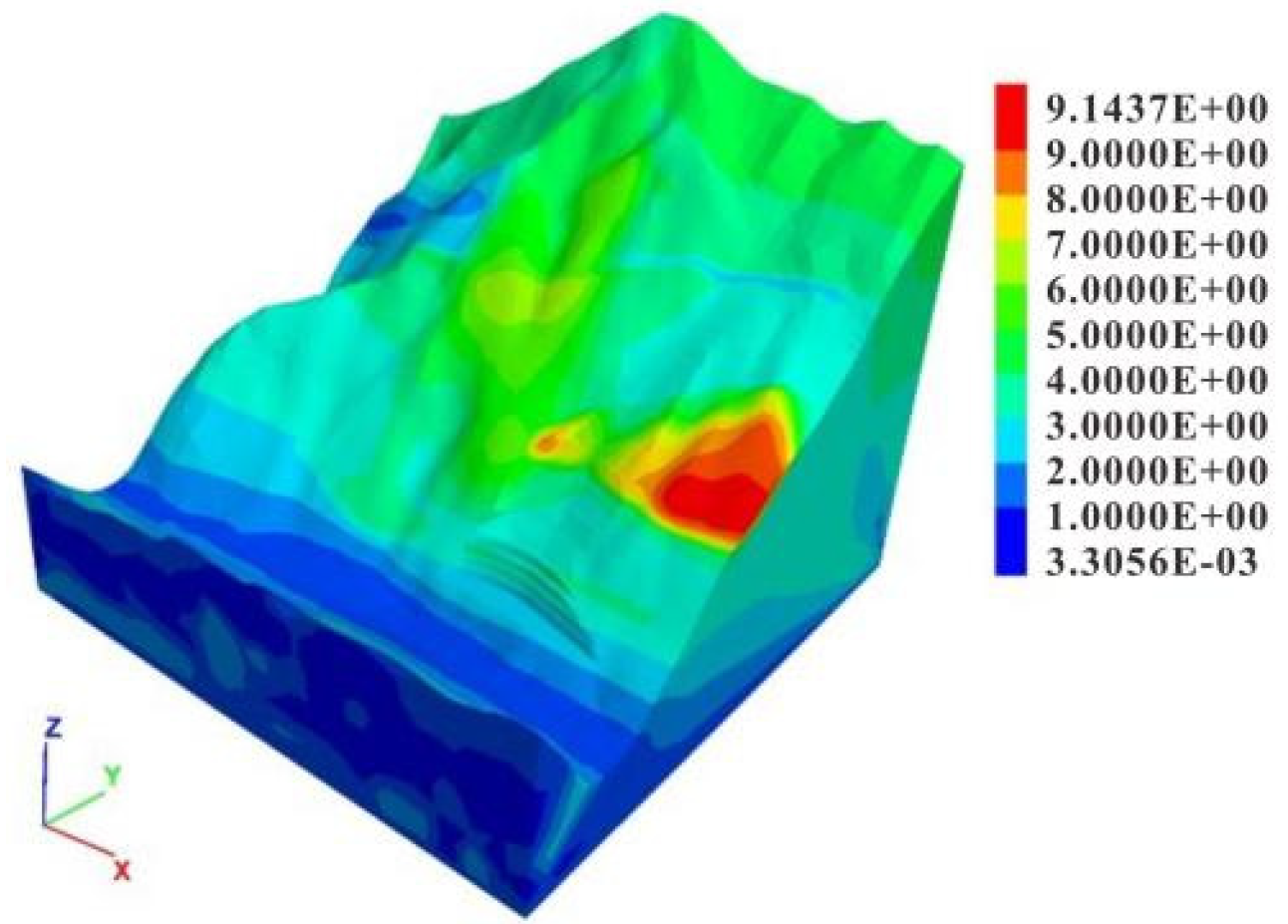


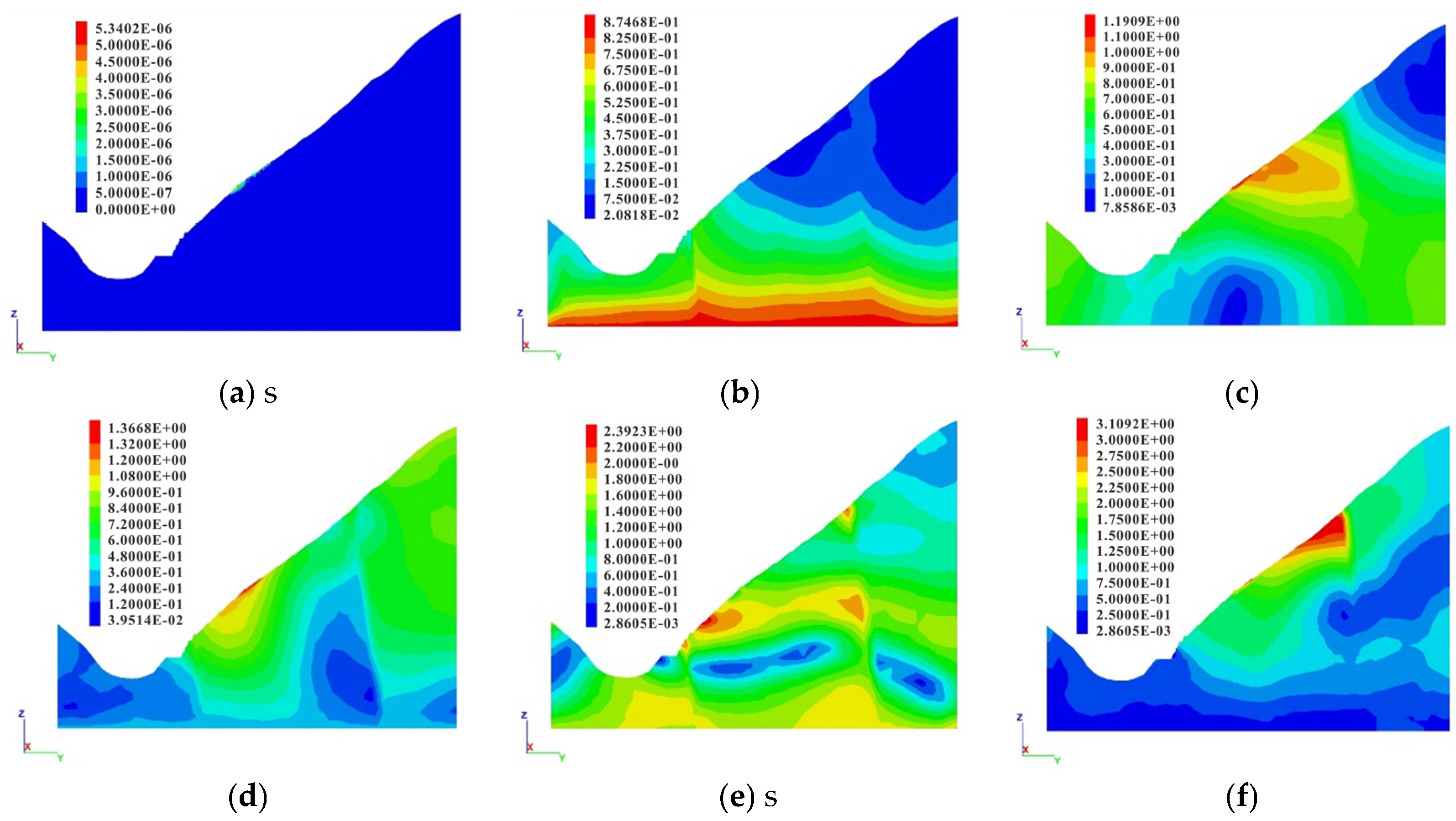
| Stratum Lithology | Unit Weight | Cohesion | Internal Friction Angle | Elastic Modulus | Poisson’s Ratio | Tensile Strength |
|---|---|---|---|---|---|---|
| (KN/m3) | (MPa) | (°) | (GPa) | |||
| Slightly weathered dacite | 26.8 | 1.2 | 50.2 | 28.38 | 0.22 | 1.6 |
| Weakly unloaded dacite | 26.4 | 0.46 | 37.7 | 12.52 | 0.25 | 1.15 |
| Strongly unloaded dacite | 26.3 | 0.3 | 32.4 | 9 | 0.29 | 0.5 |
| Cataclastic loose rock mass | 25.5 | 0.11 | 28 | 5.15 | 0.35 | 0.18 |
| Ductile shear zone | 26.2 | 0.41 | 34.70 | 9.31 | 0.26 | 0.7 |
| Strongly altered rock | 26.8 | 0.08 | 21.8 | 2 | 0.38 | 0.01 |
| Residual slope deposit | 21.99 | 0.07 | 24.99 | 1 | 0.4 | / |
| Structural Plane Type | Shear Strength | ||
|---|---|---|---|
| f′ | c′ (MPa) | ||
| Rigid | Structural plane with filling | 0.60 | 0.15 |
| Unfilled structural plane | 0.55 | 0.10 | |
| Weak | Rock block and debris | 0.55 | 0.15 |
| Cuttings with mud | 0.40 | 0.05 | |
| Mud mixed with rock debris | 0.35 | 0.04 | |
| Compression shear mylonite | 0.60 | 0.25 | |
| Weak interlayer | 0.25 | 0.05 | |
| Supporting Structure | Structural Model | Elastic Modulus | Tensile Strength | Poisson’s Ratio |
|---|---|---|---|---|
| (GPa) | (Gpa/kN/m) | |||
| Preliminary shaft micropiles | Pile | 28 | 0.4 | 0.25 |
| Reinforced MacMat | Shell | 10 | 30 | 0.3 |
Disclaimer/Publisher’s Note: The statements, opinions and data contained in all publications are solely those of the individual author(s) and contributor(s) and not of MDPI and/or the editor(s). MDPI and/or the editor(s) disclaim responsibility for any injury to people or property resulting from any ideas, methods, instructions or products referred to in the content. |
© 2025 by the authors. Licensee MDPI, Basel, Switzerland. This article is an open access article distributed under the terms and conditions of the Creative Commons Attribution (CC BY) license (https://creativecommons.org/licenses/by/4.0/).
Share and Cite
Liu, W.; Deng, H.; Tian, S. Numerical Simulation of Slope Excavation and Stability Under Earthquakes in Cataclastic Loose Rock Mass of Hydropower Station on Lancang River. Appl. Sci. 2025, 15, 7480. https://doi.org/10.3390/app15137480
Liu W, Deng H, Tian S. Numerical Simulation of Slope Excavation and Stability Under Earthquakes in Cataclastic Loose Rock Mass of Hydropower Station on Lancang River. Applied Sciences. 2025; 15(13):7480. https://doi.org/10.3390/app15137480
Chicago/Turabian StyleLiu, Wenjing, Hui Deng, and Shuo Tian. 2025. "Numerical Simulation of Slope Excavation and Stability Under Earthquakes in Cataclastic Loose Rock Mass of Hydropower Station on Lancang River" Applied Sciences 15, no. 13: 7480. https://doi.org/10.3390/app15137480
APA StyleLiu, W., Deng, H., & Tian, S. (2025). Numerical Simulation of Slope Excavation and Stability Under Earthquakes in Cataclastic Loose Rock Mass of Hydropower Station on Lancang River. Applied Sciences, 15(13), 7480. https://doi.org/10.3390/app15137480





